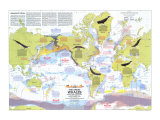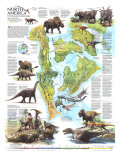Bird Migration Map - the Americas: sixty-seven full illustrations, printed at a scale of 1 inch to every 315 miles.
THE MYSTERY OF MIGRATION -
Bulging with fat for fuel, congregations of blackpool warblers wing south over the Atlantic each autumn from the coasts of New England and eastern Canada. Some pause at Bermuda or other islands, but most fly nonstop to South America – a journey of nearly 2,5000 miles at a maximum altitude of 21,000 feet. The black poll warbler is smaller than a sparrow.
The arctic tern, a much larger bird, migrates from near the top of the world to the bottom – Antarctica. Counting the return flight in spring, it may travel 25,000 miles, the earth's circumference.
Scientists don't know exactly how the migrating birds find their way over long distances, but they are discovering that birds tune in to an astonishing variety of sensory cues that may be used for navigation.
Observers have long theorized that migrants use mountain ranges, rivers, and coastlines for guidance. Scientific research suggests that some birds may also set their courses by the sun, by the patterns of stars, even by the lines of force in earth's magnetic field, perhaps in combination with gravity.
Some birds respond to ultraviolet and polarized light and can hear low-frequency sound that travels thousands of miles. Thus upland sandpipers flying high above the Mississippi conceivably could hear surf from both the Atlantic and Pacific Coasts.
How the migrants process these cues is a mystery. But the incredible facts remain: The birds know where they are, and they know where they are going.
SEABIRDS, GULLS. AND TERNS - From Antarctica the south polar skua roams as far north as the Chukchi Sea and Greenland. The wandering albatross rides stormy westerly winds of the southern latitudes. After patrolling the North Atlantic in summer, the greater shearwater returns to tiny islands in the South Atlantic to breed.
SHORE AND WADING BIRDS- Tireless fliers with rapid wingbeats, the American golden plover and the white-rumped sandpiper fly spectacular distances from their tundra homes. Some plovers head to pacific islands; others migrate to the Argentine pampas. Sandpipers may go as far south as Tierra del Fuego.
After a summer in salt lakes and marshes at 13,000 feet, the Andean flamingo merely changes altitude a bit, descending to wetlands at about 10,000 feet.
LAND BIRDS AND BIRDS OF PREY - Though most of these birds migrate over land, some venturesome species–like the blackpoll warbler–winters in the Bahamas. The tiny ruby-throated hummingbird crosses the Gulf of Mexico at twenty miles an hour en route to Central America. The peregrine falcon occasionally hitches rides on ships.
WATERFOWL - The wide-ranging brant breeds in the arctic regions. Different flocks winter from British Columbia to Baja California. Others choose Chesapeake Bay and Cape Hatteras. Still others head for Europe.
The South American rosy-billed pochard migrates in a 2,000-mile loop: From nests in marshes north of Buenos Aires it travels to lakes in Andean foothills to feed, thence to marshes in southern Brazil and back to the breeding area.
















